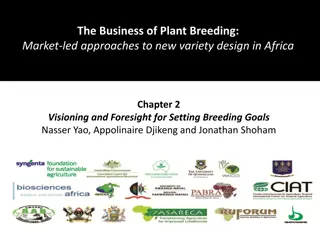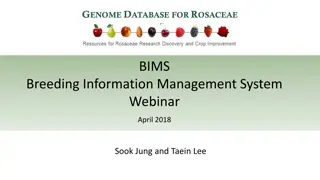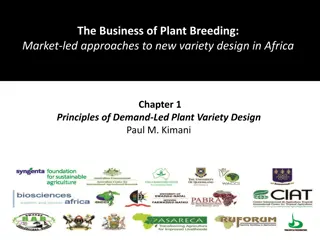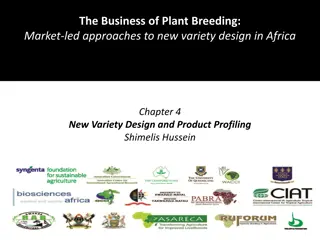Effective Variety Development Strategy for Plant Breeders in Africa
This chapter focuses on the importance of constructing a high-quality, well-documented demand-led breeding strategy and development stage plan for plant breeders in Africa. It emphasizes stakeholder engagement, rigorous decision-making, and activity planning to ensure efficient variety development and successful farmer adoption. The content covers aspects such as crop supply and demand landscape, policy considerations, market analysis, target clients, intellectual property, project governance, seed systems, monitoring performance, and risk management.
Download Presentation

Please find below an Image/Link to download the presentation.
The content on the website is provided AS IS for your information and personal use only. It may not be sold, licensed, or shared on other websites without obtaining consent from the author. Download presentation by click this link. If you encounter any issues during the download, it is possible that the publisher has removed the file from their server.
E N D
Presentation Transcript
The Business of Plant Breeding: Market-led approaches to new variety design in Africa Demand-Led Plant Breeding Training Manual Chapter 5 Variety Development Strategy and Stage Plan Rowland Chirwa
Chapter 5 Variety Development Strategy and Stage Plan Rowland Chirwa Chitedze Agricultural Research Station P.O. Box 158, Lilongwe, Malawi
Chapter 5 Objectives 1. Variety development strategy and stage plan: To enable plant breeders to construct a high quality, well- documented demand-led breeding strategy and a development stage plan, to enable good governance, rigorous decision- making and activity planning within a demand-led breeding project. 2. Stakeholder engagement: To ensure the variety development strategy and stage plan allow for involvement of stakeholders at key decision points on: The design, development and release of new varieties; Enabling new varieties to reach farmers; and Provide feedback on product performance and farmer adoption.
Contents 1. New variety development strategy 2. Development stage plan 3. Timelines and critical paths 4. Risk management 5. Variety registration
Variety Development Strategy A development strategy defines the core breeding goal and creates a framework for decision-making and investment. The strategy analyses the external environment, defines problem and answers key questions on the product being developed: what , why , for whom and how ? The strategy has a broader scope than a development plan and considers the end product and adoption. It should precede preparing the development stage plan.
Variety Development Strategy 1. Crop supply and demand landscape - the problem 2. Policy and enabling environment 3. Market analysis 4. Target clients and market segments 5. Variety design and market positioning 6. Intellectual property 7. Development stage and activity plan/timetable 8. Development costs 9. Development investment case 10. Project governance and decision-making 11. Client awareness and raising demand 12. Seed system and delivery to farmers 13. Monitoring post-release performance and adoption 14. Performance measures and risk management
Group exercise Development Strategy What should a variety development strategy contain? Why does each component matter in a demand-led breeding programme? What are the benefits of creating a development strategy?
Development Stage Plan A stage plan is the key tool for supporting timely decision-making and if a new genotype/line is ready for progression to the next stage and further investment. It contains all activities needed to deliver a new variety from initial design to use by farmers. Activities are mapped onto different stages of progression along the timeline. Stages are directly linked and so must communicate with each other.
Development Stage Plan A Stage Plan includes the following key activities: Development planning Variety design Breeding, testing and evaluation Variety registration and scale up Seed production Monitoring and evaluation at all stages of the variety development process
Five key elements of the Stage Plan 1.Development planning: Brings in constructive ideas from all key stakeholders. 2.Variety design: Makes decisions on the type of a variety to be developed according to the criteria set by clients. 3.Breeding and evaluation: Identifying key resources (funds, personnel, facilities and institutions) required to determine a critical path and shortest route to delivery of the variety. 4.Variety registration and scale-up: Essential for plant breeders to understand the registration requirements, costs and timelines; and engage with regulatory officials from an early stage. 5.Seed distribution and farmer access to seed: Access to high quality, affordable seed to drive adoption and success of variety.
Demand-led Breeding Stage Plan Line progression decisions Investment Decision Product Launch Commercial Candidates Product discontinuation of specific products in specific market segments selected requiring characterization, scaling-up and regulatory approval Products that have completed discontinuation activities, and stock removed from inventories Initiation of research on germplasm aligned to the product concept Product concept Breeding & Selection Product Evaluation and Scale-up Life Cycle Management Proof of Concept Variety Design Early Late F Pre- A E C D H B G Discovery Discontinue Commercial Development Development Commercial Identification, characterization and selection of specific traits to be used Market research. Product prototype characterization and selection based on performance in replicated trials and wider evaluation Preparing for launch Stop sales Elimination of inventory Line Small plot screening of products as commercial prototypes Product sales Discovery Product profile creation. Development Investment case created. Development. Development and screening of product components or pre-products rather than products Launch Rapid Growth Peak Sales Sales Decline Modified version of Syngenta Seeds stage plan Key Phase Stage Gate decision point Stage Stage activities
Example: Developing a Small White Pea Bean Variety in Zimbabwe Line progression decisions Investment Decision Product Launch Commercial Candidates Product discontinuation of specific products in specific market segments selected requiring characterization, scaling-up and regulatory approval Products that have completed discontinuation activities, and stock removed from inventories Initiation of research on germplasm aligned to the product concept Product concept Breeding & Selection Product Evaluation and Scale-up Life Cycle Management Proof of Concept Variety Design Early Late F Pre- A E C D H B G Discovery Discontinue Commercial Development Development Commercial Discovery Identify traits: 1. Colour white 2. Seed size: 18 g 3. Disease resistance: < 3 4. Drought resistance 5. Canning quality: (HC > 1.7 and PWDWT > 60%) 1. Market demands baked bean 2. Product profile: small white canning bean 3. Investment case: Industry requires 360 tons/yr Product prototype: Test varieties in large plots, replicated trials (IVT and AVT) and also on-farm with farmers, traders and industry and select based on set criteria Preparing for launch: 1. Conduct DUS and VCU for variety release 2. Conduct massive demonstration plots with partners Stop sales Elimination of inventory Line Development: Identify parent lines Generate segregating populations these pre- products rather than products Screen lines in small plots (nurseries and PVT) together with farmers, industry and relevant officials in variety registration Product sales: Launch new varieties with massive seed production, distribution promotion and sales until sales decline Modified version of Syngenta Seeds stage plan Stage Stage Gate decision point Key Phase Stage activities
Benefits of Using a Stage Plan Product adoption: Higher likelihood of varieties achieving increased farmer adoption by meeting clients demands Decision-making: Enables greater focus on key milestones, generation of quality data and information required for rigorous and informed decisions Fully integrated plan: Encourages excellent planning to seek efficiencies and a smooth flow of activities from start to completion of the new variety development Communications: Provides a visualization framework to show progress of many lines under development within a breeding program or institution s new variety portfolio
Summary of Development Stage Plan Essential planning process for all breeding programmes. Contains all activities needed to deliver a new variety from initial design to use by farmers - mapped at all the different stages of progression along the timeline. Useful not only to organise activities but also to gain inputs, support and pull through from clients at critical timings in the variety development process. Important for effective communications amongst client groups and experts from different disciplines, both within each stage and across the stages. Key tool to support timely decision-making and if a new genotype/line is ready for progression to the next stage and merits further investment.
Group Discussion Development Stage Plan In your breeding programmes, who makes the decisions and how are the decisions made to progress germplasm - from creating crosses, through varietal release, up to final de-registering the variety from production? At which points in the stage plan should clients, management and investors be involved in decision making?
What is a Critical Path? Definition: The variety development stage plan has a series of steps to design, create and deliver the new variety to farmers. The shortest possible route from design to delivery is called the critical path
Critical Path Analysis Diagram with Risk Dependencies Activity New variety breeding programme 9 10+ 2 3 8 1 4 5 6 7 Years Activity 1 Critical path Dependency risk Activity 2 Activity 3 Activity 4 Activity 5 Activity 6 Activity 7 Activity 8 Activity 9 Activity 10
Timeline and critical path for developing a new drought tolerant and micronutrient dense sugar bean variety with resistance to ALS and BCMV diseases in Zimbabwe Activity TIME FRAME (YEARS) Yr 4 Yr 5 Yr 1 Yr 2 Yr 3 Yr 6 Yr 7 Yr 8 Yr 9 Yr 10 1. Make crosses (parent A -Sugar bean) x (parent B -drought and high Zn); (parent C - ALS ) x (parent D - BCMV and high Fe) to get F1 seeds for single and double crosses in the greenhouse by the breeder 2. Plant the 4-way F1 seeds in the field under controlled conditions to generate as much seed as possible at F2 generation under rainfed and generate F3s under irrigation by the breeder 3. Plant F3s in a targeted environment for ALS and BCMV screening and select plants with desirable target traits to produce F4 seeds, and plant the F4s under irrigation to get F5 seeds by the breeder and collaborating partners or stakeholders, depending on the traits of interest 4. Evaluate F5 lines in a single row nursery, and select best lines for grain type and yield, but also for ALS and BCMV, while increasing seed for the next season, and plant F6s to screen under drought, but also to generate F7 seeds sample some plants from promising rows and harvest the seeds separately for mineral content analysis - by the breeder and collaborating partners or stakeholders, depending on the traits of interest 5. Evaluate selected fixed lines from drought screening in multilocation variety trials (PVT for one season, IVT for one season and AVT for two seasons) and select the best lines for yield, disease resistance and grain type by the breeder and collaborating partners or stakeholders, depending on the traits of interest 6. Conduct on-farm trials with stakeholders to capture clients preferences 7. Confirm the Fe and Zn content in selected bean lines 8. Conduct Distinctiveness, Uniformity and Stability (DUS) and Value for Cultivation and Use (VCU) tests by the designated DUS testing unit 9. Submit to Variety Release Committee (VRC) for variety release and registration by the breeder and the variety release committee
Importance of Timelines and Critical Path Understand the timelines and associated costs to develop and register a new variety. Clear understanding about critical paths and approaches to risk reduction. Develop risk mitigation strategies. Understand costs and rewards associated with risks. Critical path analysis and pro-active risk management will help breeding team to develop new varieties that meet farmer and value chain needs in a timely and cost- effective manner.
Risk Management There are many types of hazards, incidences and problems that can occur during varietal development that can cause delays and even through to non-delivery. In the case of planning, some scientific activities by their innovative nature may provide unexpected results. Where the outcomes of experiments are uncertain and may require repeating, then it is advisable, if possible, to schedule them earlier in the plan and not just-in time . Risk can also be reduced by using parallel approaches to increase the chances of a successful output, if resources permit.
Risk Quantification Identified risk Person responsible Impact Likelihood Risk reduction action New PCR method/lab contamination Molecular biologist Industrial cleaning lab, restricted access High 20% Farmer communication, signboards in field Send in 2 lots, via specialist shipment company Field experiment off-site destroyed Field agronomist High 20% Lost shipment of seed samples Seed bank manager Mod 60% Head of breeding team Organize back-up contractor/more $ in budget Delayed recruitment of staff/specialist High 50%
Risk Quantification Probability theory: Multiply not add individual chances of success to see the combined effect of all risks. The combined effect of the concurrent major risks with high impact in the example below is much greater than one may think intuitively. Combined risk effect: example - Risk 1 High impact 60% prob. = chance of success 0.4 Risk 2 High impact 50% prob. = chance of success 0.5 Risk 3 High impact 70% prob. = chance of success 0.3 Total chance of success 0.4 x 0.5 x 0.3=0.06 or only 6%! This may affect next decisions and course of action.
Key Messages: Timelines and Risk Management There is a need to determine optimal times to integrate requirements, tests/evaluations and data generation for demand-led parameters Timescales must be clearly defined Find creative ways to not extend and preferably shorten timescales whilst including demand-led components Use critical path analysis and risk mitigation Use data to make decisions
Group Exercise: Timelines and Critical Paths What are the biggest risks in your breeding programme? How do you mitigate against these risks?
4. Variety Registration Current knowledge of registration system and release requirements is essential, at national and regional levels. Timelines and costs. Can one help to speed up the registration process by engaging with the regulatory officials?
Demand-led Variety Registration Consumer traits and regulatory hurdles. Demand-led breeding is complex and can take longer - so a smooth registration process is a key factor. Regional harmonization may influence market size and subsequent investment decisions. Demand-led variety registration may be influenced by international regulations such as UPOV, breeders rights and national registration agencies.
Demand-led Variety Registration In each country, National Variety Registration Committee (NVRC ) makes a decision to release or reject a new variety, based on data compiled in the release proposal Some countries charge a fee, others do not, for tests Ideally, release is based on merit/uniqueness of variety Uniqueness of a variety that addresses demand-led traits should be considered sufficient to distinguish a new variety from others and give it merit for release
Demand-led Variety Registration Some countries require yield improvement vs benchmark Thus the need for yield gain vs consumer demand-led traits issues need to be clarified at the variety design stage The fact that each country has its own Seed Act makes it costly for seed companies to release and market new varieties in different countries in sub-Saharan Africa One way to reduce registration costs is to harmonize variety registration regulations across countries, in regional sub groupings (e.g. SADC and COMESA countries)
The Business of Plant Breeding: Market-led approaches to new variety design in Africa Demand-Led Plant Breeding Training Manual Chapter 5 Variety Development Strategy and Stage Plan Rowland Chirwa

























